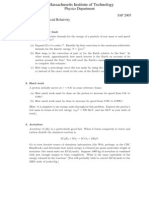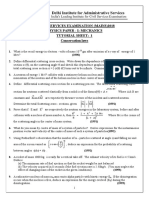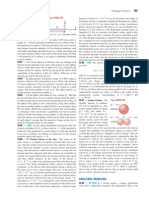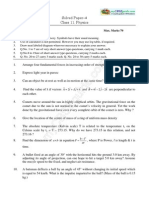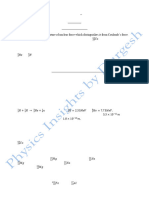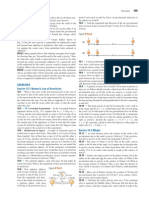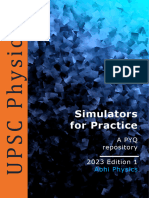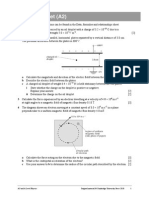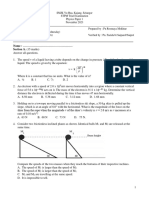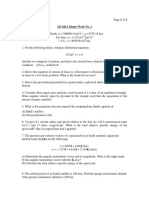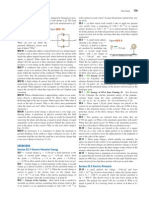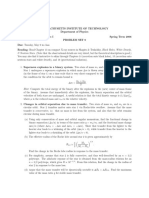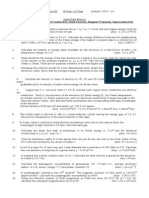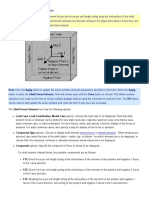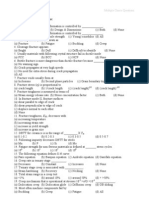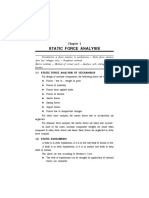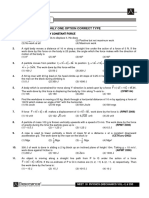PH 201 Tutorial 3
PH 201 Tutorial 3
Uploaded by
Mukul SuryawanshiCopyright:
Available Formats
PH 201 Tutorial 3
PH 201 Tutorial 3
Uploaded by
Mukul SuryawanshiOriginal Description:
Copyright
Available Formats
Share this document
Did you find this document useful?
Is this content inappropriate?
Copyright:
Available Formats
PH 201 Tutorial 3
PH 201 Tutorial 3
Uploaded by
Mukul SuryawanshiCopyright:
Available Formats
Tutorial Sheet III - Nuclear Physics & Relativity
PH 201 P HYSICS (B.T ECH . - II Y EAR ) S PRING 2013
1. Calculate the binding energy of 126 52 Te, given its mass to be 125.903322 u. 2. What is the energy require to remove the least tightly bound neutron from 39 M (40 20 Ca) = 39.962589 u and M (20 Ca) = 38.970691 u .
40 Ca 20
[Ans. 1.066 GeV] ? given the masses [Ans. 15.6 MeV]
3. Assuming the nuclear radius as r = r0 A1/3 , r0 = 1.2 fm and u = 1.66 1027 kg, calculate the mass density of 12 C nucleus. [Ans. 2.3 1017 kg/m3 ] 4. (a) Calculate the electrostatic energy of a charge Q distributed uniformly throughout a sphere of radius R. [Ans. 3Q2 /(5R)]
27 (b) Since 27 14 Si and 13 Al are mirror nuclei, their ground states are identical except for charge. If their mass difference is 6 MeV, estimate their radius (neglecting the proton-neutron mass difference). [Ans. 3.88 fm]
5. What is the Coulomb repulsion energy of the two protons in 2 2 He if it is assumed that they are separated by a nuclear radius? [Ans. 0.71 MeV] 6. Mirror nuclei have the same odd value of A, but the values of N and Z are interchanged. Determine the mass difference between two mirror nuclei which have N and Z differing by one unit. [Ans. m p mn + a3 A2/3 ]
23 7. The masses of 23 11 Na and 12 Mg are 22.989771 u and 22.994125 u, respectively. From these data determine the constant a3 in the semiempirical mass formula. [Ans. 0.598 MeV]
8. The nuclear binding energy may be approximated by the empirical expression B.E. = a1 A a2 A2/3 a3 Z 2 A1/3 a4 (A 2Z )2 A1 . (a) Considering a set of isobaric nuclei, derive a relationship between A and Z for naturally occurring nuclei. [Ans. Z = A/(2 + 2aa34 A2/3 )] (b) From this expression can you explain why in heavy nuclei the number of protons is considerably less than the number of neutrons. 9. In the ssion of a nucleus of mass number A0 (mass M0 ) into two nuclei A1 and A2 (masses M1 and M2 ), the energy released is Q = M0 c2 M1 c2 M2 c2 . (a) If (A) = B.E ./A, express Q in terms of (A) and A. [Ans. Q = A1 (A1 ) + A2 (A2 ) A0 (A0 )] (b) Estimate Q for symmetric ssion of a nucleus with A = 240 assuming (120) 8.5 MeV and (240) 7.6 MeV (These values can be read from the B.E./A curve in any text book). [Ans. 216 MeV] (c) Estimate (order of magnitude) the ratio of the energy released when 1 g of the above nucleus (A = 240) undergoes ssion to the energy released when 1 g of TNT explodes (2.6 1022 eV). [Ans. 2 107 ] 10. The period of a pendulum is measured to be 3.0 s in the reference frame of the pendulum. What is the period when measured by an observer moving at a speed of 0.95 c relative to the pendulum? [Ans. 9.6 s]
11. An astronaut takes a trip to Sirius, which is located a distance of 8 lightyears from the Earth. (Note that 1 lightyear (y) is the distance light travels through free space in 1 yr.) The astronaut measures the time of the one-way journey to be 6 yr. If the spaceship moves at a constant speed of 0.8c, how can the 8-y distance be reconciled with the 6-yr trip time measured by the astronaut? [Ans. 6 yr] 12. Compare the momentum of an electron when it has a speed of (a) 4.00 107 m/s in the CRT of a television set, and (b) 0.98c in an accelerator used for cancer therapy. [Ans. 1.01 me v, 5.0 me v] 13. When two moles of hydrogen and one mole of oxygen react to form two moles of water, the energy released is 484 kJ. How much does the mass decrease in this reaction? [Ans. 5.38 1012 kg] 14. (a) A Tevatron accelerator at Fermilab in Illinois (USA) cam accelerate protons to a kinetic energy of 1.0 TeV (1012 eV). What is the speed of such a proton? (b) What magnetic eld intensity is needed to keep 998-GeV protons revolving in a circle of radius 1.0 km? Use the relativistic mass. [Hint: in relativity, it is still true that mv2 /r = qvB in a magnetic eld.] 15. (a) Find the rest energy of a proton in electron volts. (b) If the total energy of a proton is three times its rest energy, with what speed is the proton moving? (c) Determine the kinetic energy of the proton in electron volts. (d) What is the protons momentum? 16. Imagine a motorcycle moving with a speed 0.8 c past a stationary observer. If the rider tosses a ball in the forward direction with a speed of 0.7 c relative to himself, what is the speed of the ball relative to the stationary observer? 17. The Sun radiates energy at a rate about 4 1026 W. (a) At what rate is the Suns mass decreasing? (b) How long does it take for the Sun to lose a mass equal to that of Earth? (c) Estimate how long the Sun could last if it radiated constantly at this rate. 18. Two identical particles of rest mass m0 approach each other at equal and opposite speeds v. The collision is completely inelastic and results in a single particle at rest. What is the rest mass of the new particle? How much energy was lost in the collision? How much kinetic energy is lost in this collision? 19. A person on a rocket traveling at 0.5 c (with respect to the Earth) observes a meteor come from behind and pass her at a speed she measures as 0.5 c. How fast is the meteor moving with respect to the Earth? 20. A 42,000 kg spaceship is to travel to the vicinity of a star 6 light-years from Earth. Passengers on the ship want the (one-way) trip to take no more than 1.0 year. How much work must be done on the spaceship to bring it to the speed necessary for this trip?
Constants: m p = 1.007825 u, mn = 1.008665 u c2 = 931.5 MeV/u e2 = 1.44 MeV fm Rest mass of electron me = 9.109 1031 kg ******
You might also like
- Electron PhysicsDocument8 pagesElectron PhysicsMaryam KiyaniNo ratings yet
- Physics II Problems PDFDocument1 pagePhysics II Problems PDFBOSS BOSSNo ratings yet
- Physics 8.20 IAP 2005 Introduction To Special Relativity Problem Set 4Document6 pagesPhysics 8.20 IAP 2005 Introduction To Special Relativity Problem Set 4Julio Balbin AriasNo ratings yet
- Upsc Physics Optional Tutorial Sheets PDFDocument51 pagesUpsc Physics Optional Tutorial Sheets PDFpankaj ahlawatNo ratings yet
- Problems in Special Relativity With Solutions - UG CambridgeDocument3 pagesProblems in Special Relativity With Solutions - UG Cambridgegooli0% (2)
- Physics II Problems PDFDocument1 pagePhysics II Problems PDFBOSS BOSSNo ratings yet
- Nuclear PhysicsDocument20 pagesNuclear PhysicsDeepanshu yadav bantkhani 501No ratings yet
- CBSE Class 11 Physics Sample Paper-08 (Solved)Document22 pagesCBSE Class 11 Physics Sample Paper-08 (Solved)cbsesamplepaperNo ratings yet
- T1 - Conservation LawsDocument3 pagesT1 - Conservation Lawsparvesh.nehra9978No ratings yet
- CBSE Class 11 Physics Sample Paper-09 (Solved)Document23 pagesCBSE Class 11 Physics Sample Paper-09 (Solved)cbsesamplepaper0% (1)
- SJPO 2013 Special - Round PDFDocument7 pagesSJPO 2013 Special - Round PDFziwei_from_chinaNo ratings yet
- Spring 2010 Qualifying ExamDocument7 pagesSpring 2010 Qualifying ExamrujintoNo ratings yet
- Classical Tutorial Sheet - PYQ CSE RevisedDocument54 pagesClassical Tutorial Sheet - PYQ CSE RevisedAditya SinghNo ratings yet
- Problems Based On Space Weather and Space RadiationsDocument5 pagesProblems Based On Space Weather and Space RadiationsAnurag RanaNo ratings yet
- Practice With SHM & Gravity With AnswersDocument6 pagesPractice With SHM & Gravity With AnswersMichelle ChenNo ratings yet
- Fisdas1 Tugas 3 FixDocument9 pagesFisdas1 Tugas 3 FixNopran KurniawanNo ratings yet
- 16 Physics SampleDocument11 pages16 Physics SampleMyra FongNo ratings yet
- SJPO Special Round 2011 Sample PDFDocument10 pagesSJPO Special Round 2011 Sample PDFziwei_from_chinaNo ratings yet
- SubAtomic Solutions 10Document8 pagesSubAtomic Solutions 10Baljinder KaurNo ratings yet
- Ss3 1st Term PhysisDocument66 pagesSs3 1st Term PhysisDada RasheedNo ratings yet
- Nuclei Revision SheetDocument4 pagesNuclei Revision SheetSanvi SharmaNo ratings yet
- Unit-5 Topic-7 Astrophysics and Cosmology Answers (End-Of-Chapter & Examzone)Document8 pagesUnit-5 Topic-7 Astrophysics and Cosmology Answers (End-Of-Chapter & Examzone)Avrinox100% (3)
- Gravitation AssignmentDocument3 pagesGravitation AssignmentShiva Ram Prasad PulagamNo ratings yet
- Cbse Mixed Test Paper-01Document12 pagesCbse Mixed Test Paper-01kamalkantmbbsNo ratings yet
- S5 ANP_Physics Exam FinalDocument8 pagesS5 ANP_Physics Exam Finalfidele ingabireNo ratings yet
- Episode 404 3 Gravitational Field Between The Earth and The Moon - 0Document5 pagesEpisode 404 3 Gravitational Field Between The Earth and The Moon - 0Leandro LeãoNo ratings yet
- NucleiDocument2 pagesNucleiffhollywhaleNo ratings yet
- Physics I Problems PDFDocument1 pagePhysics I Problems PDFBOSS BOSSNo ratings yet
- Estonian Finnish Physics Olympiad 2012Document6 pagesEstonian Finnish Physics Olympiad 2012Science Olympiad Blog100% (2)
- Numerical Problems-1Document2 pagesNumerical Problems-1Hur ZaheerNo ratings yet
- StimulatorDocument130 pagesStimulatormynotes2024rrNo ratings yet
- August 2015 Qualifying ExamDocument4 pagesAugust 2015 Qualifying ExamrujintoNo ratings yet
- Lucky Questions RelativityDocument31 pagesLucky Questions Relativityer_aman11No ratings yet
- Worksheet 26 PDFDocument3 pagesWorksheet 26 PDFVijay BhaskarNo ratings yet
- 11 Physics Sample Papers Solved 05Document24 pages11 Physics Sample Papers Solved 05Shivam GargNo ratings yet
- Orbit DecayDocument5 pagesOrbit DecayJames MorseNo ratings yet
- Gravitaion and Central ForceDocument4 pagesGravitaion and Central ForceKrisnendu BiswasNo ratings yet
- Problem Set 4Document5 pagesProblem Set 4James ConnaughtonNo ratings yet
- CP1 June 2018Document5 pagesCP1 June 2018Sifei ZhangNo ratings yet
- Trialstpm 2023 YUHUApaper 1 QuestionDocument6 pagesTrialstpm 2023 YUHUApaper 1 QuestionMathew Cheng Yu HaoNo ratings yet
- 1st Online Astro CompetitionDocument7 pages1st Online Astro CompetitionChampion ReaderNo ratings yet
- HW 1 2018Document2 pagesHW 1 2018Shaharukh KhanNo ratings yet
- Ch44 Nuclear MCQDocument14 pagesCh44 Nuclear MCQmt1403No ratings yet
- Nuclei QaDocument12 pagesNuclei Qasakthichinnaiyan1709No ratings yet
- Fall 2009 Qualifying ExamDocument6 pagesFall 2009 Qualifying ExampaimoNo ratings yet
- CP1 June 2019Document6 pagesCP1 June 2019Sifei ZhangNo ratings yet
- Applied PhysicsDocument5 pagesApplied Physicsahmad irtisamNo ratings yet
- Physics 11 Fall 2012 Practice Problems 7 - SolutionsDocument10 pagesPhysics 11 Fall 2012 Practice Problems 7 - SolutionsajjagottuNo ratings yet
- Problems08 AnsDocument9 pagesProblems08 AnsqvrlenarasegtNo ratings yet
- Module 4-QUANTUM-PROBLEMS-SENT-2023Document2 pagesModule 4-QUANTUM-PROBLEMS-SENT-2023tvkhang93182018No ratings yet
- JNU MSC 2006 PDFDocument3 pagesJNU MSC 2006 PDFGurvir SinghNo ratings yet
- 8S2 April - PhysicsDocument30 pages8S2 April - PhysicsPooja SharmaNo ratings yet
- SolutionDocument28 pagesSolutionasrikdatta12No ratings yet
- Introduction To Plasma Physics and Controlled Fusion Notes For Journal 1Document18 pagesIntroduction To Plasma Physics and Controlled Fusion Notes For Journal 1api-272993678100% (1)
- Physics II Problems PDFDocument1 pagePhysics II Problems PDFBOSS BOSSNo ratings yet
- KD4010 - EM - Seminar - 5 - ProblemsDocument2 pagesKD4010 - EM - Seminar - 5 - Problemsmohamed redaNo ratings yet
- Ps 9Document2 pagesPs 9endapallikartheeNo ratings yet
- Electricity, Magnetism and RelativityDocument5 pagesElectricity, Magnetism and Relativityyoussof.131006No ratings yet
- Phy QP 4 PrescreeningDocument2 pagesPhy QP 4 PrescreeningAbhinav MadheshiyaNo ratings yet
- Forensic Science International Genetics 2016 NovroskiDocument13 pagesForensic Science International Genetics 2016 NovroskiMukul SuryawanshiNo ratings yet
- HPLC - FingerprintDocument8 pagesHPLC - FingerprintMukul SuryawanshiNo ratings yet
- PH-201 Tutorial - 2Document2 pagesPH-201 Tutorial - 2Mukul SuryawanshiNo ratings yet
- Tutorial I (Intro To Coal) - 3Document1 pageTutorial I (Intro To Coal) - 3Mukul SuryawanshiNo ratings yet
- Marketing: Prof. Jogendra Nayak Department of Management Studies IIT RoorkeeDocument36 pagesMarketing: Prof. Jogendra Nayak Department of Management Studies IIT RoorkeeMukul SuryawanshiNo ratings yet
- BT224 Lec2 Cells OrgansDocument57 pagesBT224 Lec2 Cells OrgansMukul SuryawanshiNo ratings yet
- Phylogenetic Analysis: Based On Two Talks, byDocument45 pagesPhylogenetic Analysis: Based On Two Talks, byMukul SuryawanshiNo ratings yet
- Teliwala Village SurveyDocument6 pagesTeliwala Village SurveyMukul SuryawanshiNo ratings yet
- CH 201 Class ActivityDocument1 pageCH 201 Class ActivityMukul SuryawanshiNo ratings yet
- CY 101coordination Compounds1Document121 pagesCY 101coordination Compounds1Mukul SuryawanshiNo ratings yet
- BM 201 AssignmentDocument12 pagesBM 201 AssignmentMukul SuryawanshiNo ratings yet
- Management: Forecasting, App, MPS, MRPDocument40 pagesManagement: Forecasting, App, MPS, MRPMukul SuryawanshiNo ratings yet
- Job LetterDocument1 pageJob LetterMukul SuryawanshiNo ratings yet
- Presented By:-Shubham Nayak 12111044 BiotechnologyDocument19 pagesPresented By:-Shubham Nayak 12111044 BiotechnologyMukul SuryawanshiNo ratings yet
- Sino - Euro Bio-Bridge: Dr. Rong Hui Gao M.D. Mba G-Med ConsultingDocument44 pagesSino - Euro Bio-Bridge: Dr. Rong Hui Gao M.D. Mba G-Med ConsultingMukul SuryawanshiNo ratings yet
- Shell Forces Stresses FormDocument4 pagesShell Forces Stresses FormYudikaWisnuPratomoNo ratings yet
- The Transformation of PhysicsDocument10 pagesThe Transformation of PhysicsVíctor Manuel Hernández MárquezNo ratings yet
- B.E. (Civil) (Semester - I) : Total No. of Questions: 12) (Total No. of Pages: 3 Seat No.Document3 pagesB.E. (Civil) (Semester - I) : Total No. of Questions: 12) (Total No. of Pages: 3 Seat No.Shivam SinghNo ratings yet
- MCQ m8Document3 pagesMCQ m8Karan BansalNo ratings yet
- Metal FormingDocument33 pagesMetal FormingJeevanantham KannanNo ratings yet
- DOM Airwalk Module 1 PDFDocument34 pagesDOM Airwalk Module 1 PDFMuhammed SabeehNo ratings yet
- Mathcad - Grout Connection HSE RulesDocument3 pagesMathcad - Grout Connection HSE RulesRayodcNo ratings yet
- Fasl 1,2zzDocument8 pagesFasl 1,2zzalvin tehraniNo ratings yet
- TP Notes PrintDocument27 pagesTP Notes Print33 Mohamed IlyasNo ratings yet
- Experiment No. 1 Density and Viscosity of LiquidDocument12 pagesExperiment No. 1 Density and Viscosity of LiquidJoevani DomingoNo ratings yet
- PTI - Sheave SPADocument5 pagesPTI - Sheave SPAvilash kumar sNo ratings yet
- DRMCDocument8 pagesDRMCkabirNo ratings yet
- LM & Collisions MaterialDocument27 pagesLM & Collisions MaterialNETHAKANI SUJATHA0% (1)
- Pump PerformanceDocument33 pagesPump PerformanceHASSAN MERNo ratings yet
- Eclipse Tutorial Solucion 2Document11 pagesEclipse Tutorial Solucion 2Jimmy Johns0% (1)
- Chapter 25: Electric PotentialDocument11 pagesChapter 25: Electric PotentialAlexNo ratings yet
- Soil Mechanics-Cie 352 Assignment 2 Due On 26/05/2021Document2 pagesSoil Mechanics-Cie 352 Assignment 2 Due On 26/05/2021Perpetual hubbyNo ratings yet
- WEP Exercise 1 To 3Document20 pagesWEP Exercise 1 To 3Rakesh Singh kushwahaNo ratings yet
- PSV Reation Force - Two Phase - Assumption Close SytemDocument4 pagesPSV Reation Force - Two Phase - Assumption Close SytemNesrine MhedhbiNo ratings yet
- OPEL INSIGNIA 2013 Automatic Transmission - 6T40 (MH8 MHH) - Description and OperationDocument53 pagesOPEL INSIGNIA 2013 Automatic Transmission - 6T40 (MH8 MHH) - Description and OperationGedas GvildysNo ratings yet
- Physics Course For StudentsDocument87 pagesPhysics Course For StudentsDragos P.No ratings yet
- Basic VibrationDocument83 pagesBasic VibrationDenstar Ricardo Silalahi100% (2)
- Torque Vs Angle of Twist: Cast IronDocument4 pagesTorque Vs Angle of Twist: Cast IronPrateek K srivastavaNo ratings yet
- Heel TurningDocument5 pagesHeel TurningShanilNo ratings yet
- Design of Slide Gate Size 1.6 X 2 MDocument4 pagesDesign of Slide Gate Size 1.6 X 2 MTarunPatra100% (3)
- Edexcel International GCSE Physics 2022 Paper PDocument5 pagesEdexcel International GCSE Physics 2022 Paper PReckanaterNo ratings yet
- Engineering Failure Analysis: Shervin Maleki, Alireza Moazezi MehretehranDocument12 pagesEngineering Failure Analysis: Shervin Maleki, Alireza Moazezi MehretehranVitor ViniciusNo ratings yet
- Behavior and Splice Length of Deformed Bars Lapping in Spirally Confined Grout Filled Corrugated DuctDocument12 pagesBehavior and Splice Length of Deformed Bars Lapping in Spirally Confined Grout Filled Corrugated DuctDaniel Saborío RomanoNo ratings yet
- Lecture Robotics1Document33 pagesLecture Robotics1N MNo ratings yet


